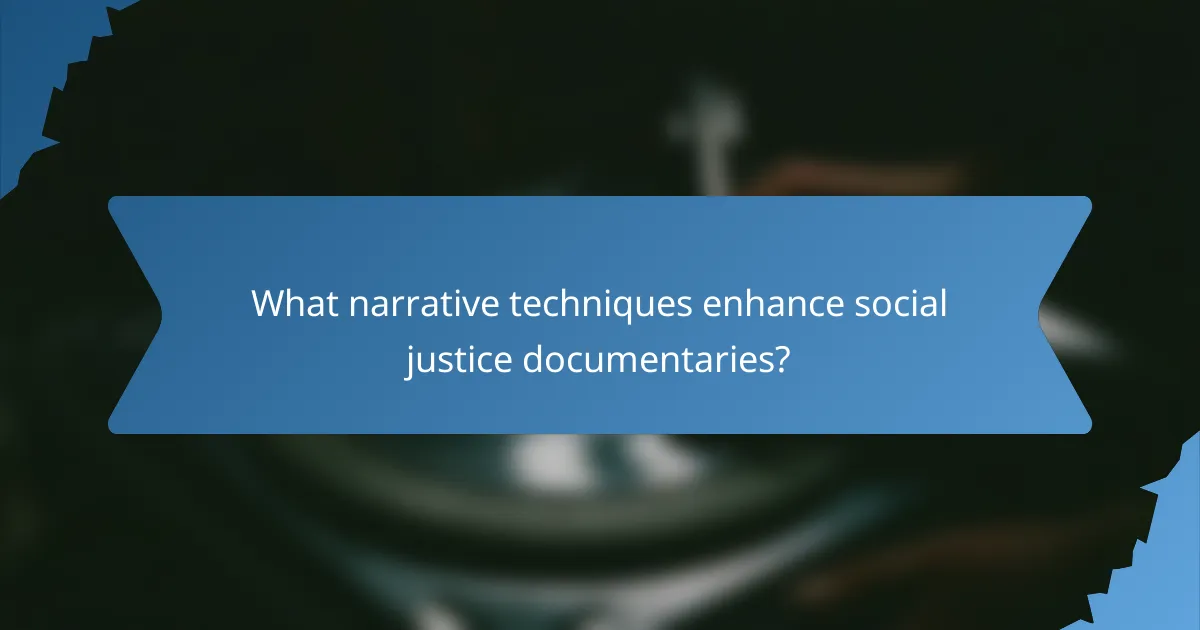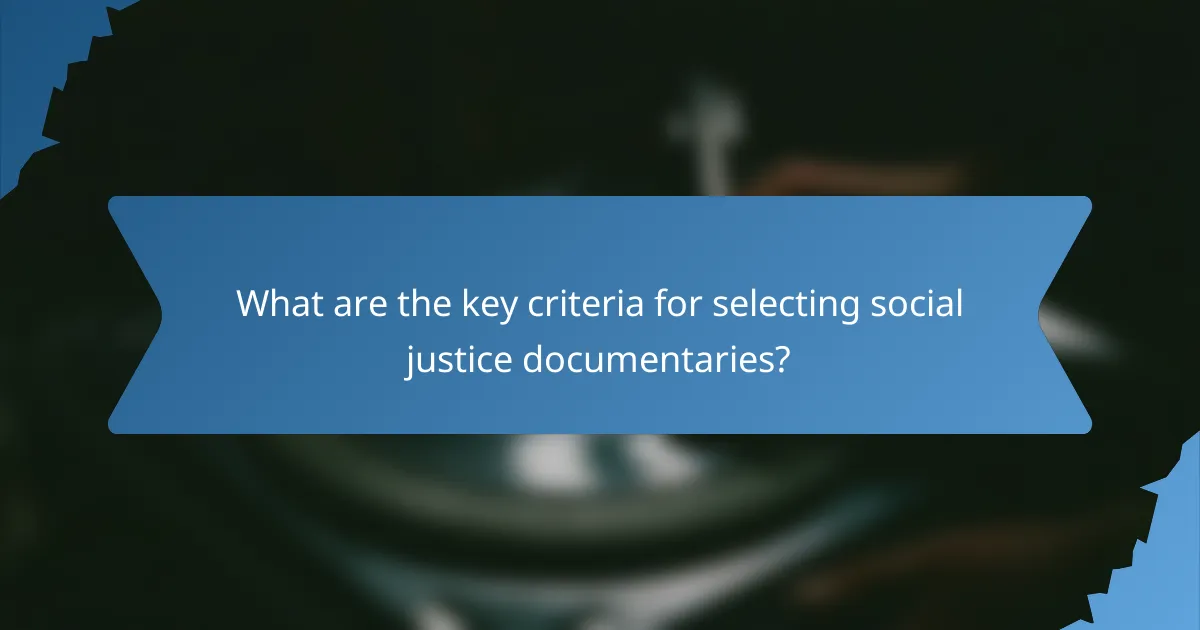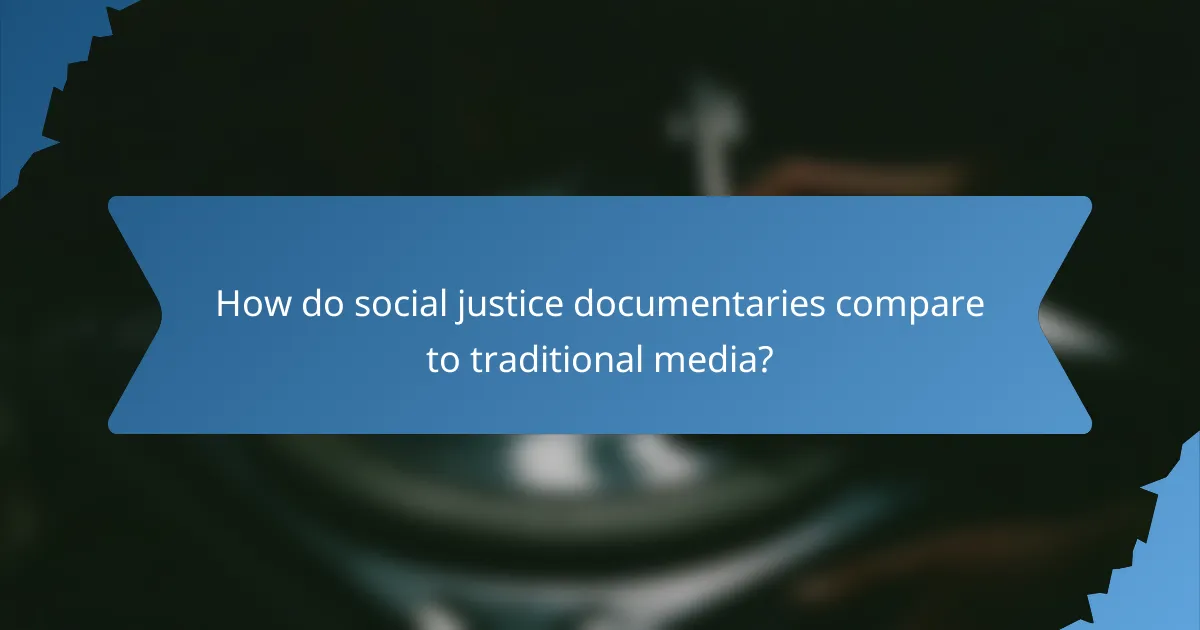Social justice documentaries serve as powerful tools for community empowerment in the UK, amplifying marginalized voices and raising awareness of local issues. Through effective narrative techniques and educational outreach, these films inspire collective action and foster solidarity, encouraging audiences to engage critically with pressing social concerns.

How do social justice documentaries empower communities in the UK?
Social justice documentaries empower communities in the UK by raising awareness of local issues and providing a platform for marginalized voices. These films often inspire collective action and foster a sense of solidarity among community members.
Community engagement initiatives
Community engagement initiatives are essential for the success of social justice documentaries. These initiatives often include workshops, screenings, and discussions that encourage local participation and feedback. By involving community members in the filmmaking process, documentaries can better reflect their experiences and concerns.
For example, a documentary about housing inequality might host community forums where residents can share their stories and contribute to the narrative. This not only empowers individuals but also strengthens community bonds.
Storytelling for social change
Storytelling is a powerful tool for social change, as it humanizes complex issues and fosters empathy. Social justice documentaries often use personal narratives to illustrate broader societal problems, making them more relatable and impactful. This approach can motivate viewers to take action or support local initiatives.
Effective storytelling techniques include using interviews, archival footage, and visual metaphors to convey messages. Documentaries that focus on personal stories of resilience can inspire viewers to engage with social justice issues in their own communities.
Local partnerships and collaborations
Building local partnerships and collaborations is crucial for the sustainability of social justice documentaries. Collaborating with community organizations, schools, and local activists can enhance outreach and ensure that the documentary reaches a wider audience. These partnerships can also provide valuable resources and support for community initiatives.
For instance, a documentary about environmental justice might partner with local environmental groups to organize screenings and discussions. This not only amplifies the documentary’s message but also encourages community members to participate in ongoing advocacy efforts.

What narrative techniques enhance social justice documentaries?
Narrative techniques in social justice documentaries are crucial for effectively conveying messages and engaging audiences. Techniques such as first-person storytelling, visual symbolism, and archival footage integration help create a compelling narrative that fosters understanding and empathy.
First-person storytelling
First-person storytelling immerses viewers in personal experiences, making the narrative relatable and impactful. By featuring individuals who have lived through social justice issues, documentaries can evoke strong emotional responses and foster a deeper connection with the audience.
Documentaries like “13th” by Ava DuVernay utilize this technique by sharing personal accounts of systemic racism and its effects. This approach encourages viewers to reflect on their own beliefs and biases, making the message more resonant.
Visual symbolism and metaphors
Visual symbolism and metaphors enhance the storytelling by providing deeper meanings and associations. Through carefully chosen imagery, filmmakers can convey complex ideas and emotions without relying solely on dialogue.
For example, a documentary might use a broken chain to symbolize the struggle for freedom and equality. Such visual elements can leave a lasting impression, prompting viewers to think critically about the issues presented.
Archival footage integration
Integrating archival footage adds historical context and authenticity to social justice documentaries. This technique allows filmmakers to connect past events with current issues, illustrating the continuity of struggles for justice.
Using archival footage, a documentary can juxtapose historical protests with contemporary movements, highlighting the ongoing nature of social justice issues. This approach not only educates viewers but also emphasizes the importance of learning from history to inform future actions.

How can educational outreach amplify the impact of social justice documentaries?
Educational outreach can significantly enhance the impact of social justice documentaries by fostering community engagement and facilitating critical discussions. By integrating these films into educational settings and community events, they can inspire action and awareness around social issues.
Workshops and discussion panels
Workshops and discussion panels provide a platform for audiences to engage deeply with the themes presented in social justice documentaries. These events can include expert speakers, activists, and filmmakers who can share insights and facilitate dialogue.
Consider organizing workshops that focus on specific issues highlighted in the documentary, allowing participants to brainstorm solutions and action plans. This interactive format encourages participants to reflect on their roles in social justice and empowers them to take informed action.
Curriculum integration in schools
Integrating social justice documentaries into school curricula can enhance students’ understanding of complex social issues. Educators can use these films as case studies to promote critical thinking and discussions about equity, justice, and community responsibility.
When selecting documentaries for educational purposes, ensure they align with learning objectives and are age-appropriate. Providing accompanying materials, such as discussion questions and project ideas, can help teachers effectively incorporate these films into their lessons.
Community screenings and Q&A sessions
Community screenings followed by Q&A sessions can create a shared space for dialogue and reflection on the issues presented in social justice documentaries. These events can be hosted in local theaters, community centers, or even online, making them accessible to a broader audience.
To maximize engagement, consider inviting local leaders or experts to participate in the Q&A sessions. This not only enriches the conversation but also connects the documentary’s themes to local contexts and encourages community members to get involved in ongoing initiatives.

What are the key criteria for selecting social justice documentaries?
Key criteria for selecting social justice documentaries include their relevance to local issues, the authenticity of the voices represented, and the frameworks used to measure their impact. These factors ensure that the documentaries resonate with audiences and effectively contribute to community empowerment.
Relevance to local issues
Documentaries should address specific social justice issues that are pertinent to the local community. This relevance helps to engage viewers and fosters a deeper understanding of the challenges faced by their neighbors. For instance, a film focusing on housing inequality in a particular city can spark local discussions and inspire action.
When evaluating relevance, consider the current socio-political climate and ongoing community struggles. Documentaries that highlight local narratives often have a stronger emotional impact and can mobilize community members towards collective solutions.
Authenticity of voices represented
Authenticity is crucial in social justice documentaries, as they should amplify the voices of those directly affected by the issues being portrayed. This means featuring individuals who have lived experiences related to the topic, rather than relying solely on external commentators. Authentic narratives foster trust and connection with the audience.
To ensure authenticity, filmmakers should prioritize inclusive storytelling practices, such as involving community members in the production process. This approach not only enriches the narrative but also empowers the subjects by giving them agency over their own stories.
Impact measurement frameworks
Measuring the impact of social justice documentaries involves assessing how effectively they inspire change or raise awareness. Frameworks for impact measurement can include surveys, audience feedback, and tracking subsequent community actions or policy changes. These metrics help filmmakers understand the effectiveness of their work.
When selecting a documentary, consider whether it has a clear strategy for evaluating its impact. This could involve partnerships with local organizations to gauge community responses or follow-up studies to assess long-term effects. A strong impact measurement framework enhances the documentary’s credibility and potential for real-world influence.

How do social justice documentaries compare to traditional media?
Social justice documentaries differ from traditional media by prioritizing the stories and experiences of marginalized communities, often aiming to inspire social change. While traditional media may focus on broader narratives, documentaries delve into specific issues, highlighting personal stories that foster empathy and understanding.
Focus on marginalized voices
Social justice documentaries emphasize the perspectives of marginalized groups, ensuring their stories are told authentically. This approach not only amplifies underrepresented voices but also challenges dominant narratives often found in mainstream media.
For instance, documentaries may feature interviews with individuals from low-income neighborhoods or communities facing systemic discrimination, providing a platform for their experiences and insights. This focus encourages viewers to engage with complex social issues on a personal level.
Long-term community engagement
Documentaries aimed at social justice often foster long-term engagement with communities by involving them in the filmmaking process. This collaboration can lead to deeper connections and sustained dialogue around the issues presented.
For example, filmmakers might conduct workshops or discussions in the communities they document, allowing residents to share their thoughts and contribute to the narrative. This engagement not only empowers the community but also helps ensure that the documentary accurately reflects their realities and aspirations.
